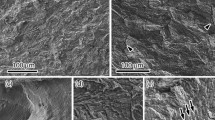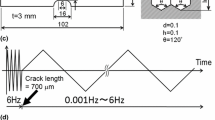Abstract
The effects of a hydrogen environment on the fatigue crack growth rates in Ti-6A1-4V ELI (STA) and weld material were determined in the temperature range of ambient to -200°F. The hydrogen environment resulted in an acceleration of the crack growth rate and a change in the fracture mode for both materials in the temperature range of ambient to -100°F. At -200°F, there was no significant difference between the crack growth rates obtained in helium and hydrogen gas. The degree of hydrogén-enhanced crack growth was found to be dependent on the crack tip stress-intensity range, temperature, and microstructure of the material. The data is consistent with an embrittlement mechanism involving hydrogen diffusing ahead of the crack front.
Similar content being viewed by others
References
W. A. Spitzig and R. P. Wei:Trans. ASM, 1967, vol. 60, p. 279.
D. P. Williams and H. S. Nelson:Embrittlement of 4130 Steel by Low-Pressure Gaseous Hydrogen, NASA-Ames Research Center.
R. W. Judy, T. W. Crooker, R. E. Morey, E. A. Lange, and R. J. Goode:Trans ASM, 1966, vol. 59, p. 195.
G. F. Pittinato:Trans. ASM, 1969, vol. 62, p. 410.
G. F. Pittinato and S. F. Frederick:Met. Trans., 1970, vol. 1, p. 3241.
H. H. Johnson,Mater. Res. Stand., 1965, vol. 5, p. 442.
G. F. Pittinato:The Electrical Potential Method for Measuring Fatigue Crack Growth in Gaseous and Aqueous Environments, unpublished research.
ASTM Symposium,Fracture Toughness Testing and Its Applications, Am. Soc. Test. Mater.,Spec. Tech. Publ. No. 381, June 21, 1964.
P. Paris and F. Erdogan:Trans. ASME, 1963, vol. 85, p. 528.
G. T. Hahn and A. R. Rosenfield:Experimental Determination of Plastic Con- straint Ahead of a Sharp Crack Under Plan-Strain Conditions, Bu Ships Contract No. BS-92383, Battelle Memorial Institute, July 1, 1966.
G. T. Hahn and A. R. Rosenfield,Acta. Met., 1965, vol. 13, p. 293.
A. S. Tetelman and W. D. Robertson:Direct Observation and Analysis of Crack Propagation in Iron-3% Silicon Single Crystals, Thesis submitted by A. S. Tetelman to the School of Engineering, Yale University, 1961.
C. Laird:Am. Soc. Test. Mater., Spec. Tech. Publ. 415, 1967, p. 131.
P. J. Forsyth:Acta. Met., 1963, vol. II, p. 703.
A. J. McEvily and R. C. Boettner:Acta. Met., 1963, vol. II, p. 725.
C. J. Smithells:Gases and Metals, 1954, vol. 4, Pergamon Press.
N. J. Petch:Phil. Mag., 1956, vol. 1, ser. 8, p. 331.
L. E. Berquist:Gauge Calibration at Extremely Low Pressures, Presented at the Fourth Int. Vacuum Congress, Manchester, England, April 1968.
J. Crank:The Mathematics of Diffusion, Oxford Univ. Press, 1956.
R. J. Wasilewski and G. L. Kehl:Metallurgia, 1954, vol. 50, p. 225.
D. M. Kokkos and S. R. Seagle:The Effects of Hydrogen on the Properties of Ti-6A1-4V, Reactive Metals Inc., Titanium Technical Bulletin, February 1967.
P. G. Shewmon:Diffusion in Solids, McGraw-Hill Series in Materials Science and Engineering, 1963.
J. D. Boyd,Trans. ASM, 1969, vol. 62, p. 977.
R. J. Walter and W. T. Chandler,Effects of High Pressure Hydrogen on Metals, NASA Contract NAS 8-19, Task 7, February 1968.
M. P. Kaplan, D. S. Cowgill, J. S. Fritzen, W. E. Kupp, S. Krystkowiak, and K. E. Weber,Corrosion-NACE, 1970, vol. 26, p. 7.
Author information
Authors and Affiliations
Rights and permissions
About this article
Cite this article
Pittinato, G.F. Hydrogen-enhanced fatigue crack growth in Ti-6Al-4V ELI weldments. Metall Trans 3, 235–243 (1972). https://doi.org/10.1007/BF02680602
Received:
Published:
Issue Date:
DOI: https://doi.org/10.1007/BF02680602




